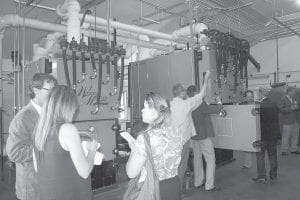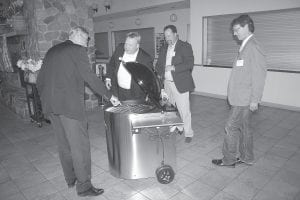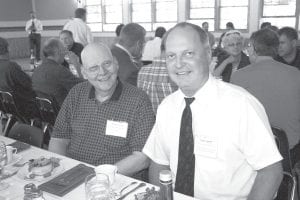Above: Two biomass boilers have been installed at Wolf Ridge Environmental Learning Center in Finland, Minnesota. Some see biomass as an excellent source of energy for northern Minnesota, with new technologies creating efficient and environmentally friendly systems. Right: (L-R) At the festivities celebrating the new system were Mike Garey of Hovland, on the Cook County Local Energy Project Biomass Work Group, and Craig Engewall, Minnesota Department of Natural Resources regional manager.

Cook County residents from Schroeder to Grand Portage turned up at Wolf Ridge Environmental Learning Center in Finland, Minnesota on June 29 for a day of tours and speeches and a ribbon-cutting ceremony inaugurating a new biomass pellet boiler system. Along with Cook County residents and business and organizational heads from Minnesota to Italy were a couple of prominent public figures – outdoor adventurer Will Steger of Ely and Swedish ambassador to the United States Jonas Hafström.
The new system, with two WoodMaster Commercial Series Boilers, will heat four buildings totaling 84,000 square feet as well as provide domestic hot water, replacing four cord wood boilers and a propane-fueled hot water heater. It could heat more than 50 homes in the Northland.
The project represents a partnership of many companies and agencies. The new boilers were manufactured by ABioNova, a Swedish company with a license from D’Alessandro Termomeccanica of Italy. Parts needing non-metric American components were made by Control Assemblies Company of Minneapolis, represented by Lakeland Engineering Equipment Company of Minneapolis. The nonprofit BioBusiness Alliance of Minnesota brought ABioNova together with Northwest Manufacturing of Red Lake Falls, which will be manufacturing and distributing the furnaces under the name WoodMaster. The underground water lines were installed by Uponor of Apple Valley, and the primary installation contractor was ABE Environmental Systems of Duluth.
The total cost of the project was about $465,000, funded in part by a $300,000 grant from the U.S. Department of Energy. The grant requires Wolf Ridge to use the biomass system in its educational programs. A lot of people will be learning about this technology, since more than 18,000 children, teachers, chaperones, family members, college students and senior citizens participate in Wolf Ridge programs each year.
For the last 25 years, Wolf Ridge has been using four GARN-brand cord wood boilers that required stoking every three to four hours and went through 160 cords of birch a year – about 640-800 trees. The logs, up to 4 feet long, cost about $26,000 a year.

Above: Biomass energy is used extensively in Sweden. (Above, L-R) On hand at the inauguration of Wolf Ridge’s new system were Jonas Hafström, Swedish ambassador to the United States; Per Carlsson, owner of ABioNova, the Swedish company that produced the boilers; and Pete Smerud, Wolf Ridge executive director. Hafstrom was presented with a WoodMaster wood-pellet-fueled barbecue grill manufactured by Northwest Manufacturing of Red Lake Falls, ABioNova’s American distributor.
The new boilers are automatically fed from a hopper and burn pellets, which are made from various kinds of wood including logs, brush, recycled materials, salvaged lumber, and scraps from paper mills and other wood product manufacturers. The boilers are expected to go through about 175 tons of pellets a year at a cost of about $31,000. They are expected to save Wolf Ridge about 50 percent of what it had been spending to heat water in the buildings that will now have hot water heated by the WoodMaster Commercial Series Boilers.
Right now, Wolf Ridge is buying pellets from Great Lakes Renewable Energy of Hayward, Wisconsin. “There is conversation about construction of a pellet plant closer to Wolf Ridge, as close as Silver Bay,” a fact sheet about the project says. “The Fond du Lac tribe is making plans in [the] Cloquet, Minnesota area as well. We built this and are hoping and supporting the idea of pellet biofuels, thus if they build it closer than Hayward, we will come.” ABioNova owner Per Carlsson of Gothenburg, Sweden said he considers Wisconsin a local source of fuel, anyway. A pellet manufacturer in Nova Scotia that first invited him to North America was exporting 75-80 percent of its product to Europe, he said.
The technology was developed for energy companies, municipalities, commercial properties, and industry facilities and is considered among the cleanest and most efficient in the industry. It uses a process called gasification, which means that after the pellets are burned, the gases produced by the burning are also burned. The system will comply with new and higher standards being set by the U.S. Environmental Protection Agency.
The fact sheet says that the new system achieves the most compete combustion possible. What’s left is a granular ash that doesn’t look like ash because it consists simply of minerals that are left after all the cellulose in the wood has been burned. “This is very different ash from the GARNs or any campfire, wood stove, etc. This is ash from truly complete combustion,” the fact sheet states.
This type of technology has been used in Europe for over 10 years.
Wolf Ridge is already using both wind power and solar power to provide energy for its buildings and plans to move into using even more renewable sources of energy.
Statements from invited guests
After a gourmet meal, Wolf Ridge Board of Trustees Chair Tom Berg of Schroeder welcomed guests, saying that Wolf Ridge’s motto fits this project perfectly: “to develop a citizenry that has the knowledge, skills, commitment, and motivation to work together for a quality environment.”
Berg introduced Will Steger, who joined Amelia Earhart, Robert Peary, and Roald Amundsen in receiving the National Geographic Society’s John Oliver La Gorce Medal and Jacques-Yves Cousteau, Thor Heyerdahl, and Neil Armstrong in receiving the Lindbergh Award.
“Any great enterprise always starts with building relationships,” said Steger. He said that Sweden, with a climate, forests, and culture similar to Minnesota, committed itself to biomass energy 30 years ago. He has been to Sweden where he heard Minnesota forests called “trashed out” and “burning.” He considers Sweden’s forests well managed and said the country has an “incredible lumber industry” that is part of a good economy. Sweden’s use of biomass is done with no pollution and no smoke, he said.
“Paper is on the way out,” Steger said of the paper industry, although he considers it still an important part of the northeastern Minnesota economy. The younger generation will be reading from their laptops, he said.
Last year’s Pagami Creek fire traveled 18 miles in one day, Steger said. He called this area’s forests “choked” with balsam, a tree that burns easily.
The potential for building a biomass cottage industry in this area is huge, “but first we have to build up demand,” Steger said. “Some of the biggest opponents of biomass are environmentalists. They see corn-based ethanol, that’s all they see.
“…You can now no longer reach the North Pole by dog sled because it’s open water,” Steger continued. “We’re losing control of the environment.” With environmental changes happening all over the world, he said, the solution is economic and political.
Minnesota is rich in wind, solar, biomass, and geothermal energy, Steger said. “We have to really develop renewable fuels.”
As people see renewable energy systems work, they will start investing in them, Steger said. “Seeing is believing.”
Dale Wahlstrom, president and CEO of BioBusiness Alliance of Minnesota, said Steger has demonstrated “the ability to try when most people have quit” – something the Swedish community has done as well. He said Steger’s “explorer’s spirit and lack of fear” are the types of traits needed to realize the potential of biomass.
Swedish Ambassador Jonas Hafström commended the partnership between Sweden and American businesses. “These are exactly what we hope to see in Swedish businesses,” he said.
“Sweden takes the challenge of energy and climate change technology very seriously,” Hafström said. In the 1970s, 80 percent of their energy came from fossil fuels. Today, fossil fuels account for only 40 percent of the nation’s energy use. He hopes to see transportation weaned off fossil fuels by 2030.



Loading Comments